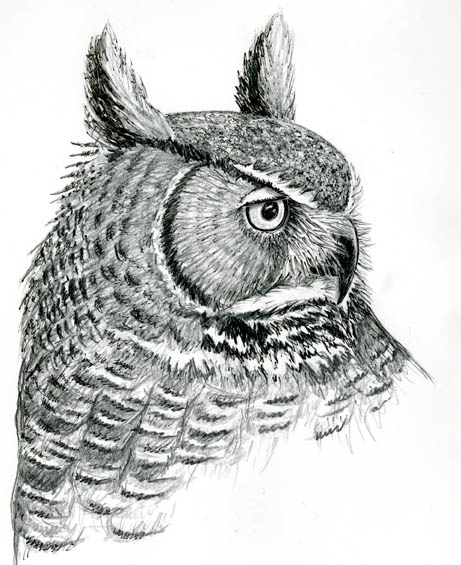
Dear Bird Folks,
I just know that the “horns” on the Great Horned Owl are not horns or ears, but merely tufts of feathers that have nothing to do with the bird’s ability to hear. What purpose do they serve? Are the tufts useful somehow or do the birds grow them just for decoration?
– Rita, Eastham, MA
They’re not decorations, Rita,
No animal, not even us ultra-vain humans, has the ability to grow their own extra parts for decoration. Believe me, I wish we could grow whatever parts we wanted to. I would probably grow a different nose. I would definitely grow more hair, and perhaps improve another body part or two, but I’m not going to get into right now. The ear tufts on the Great Horned Owls are not for decoration; they have a definite purpose. Too bad no one knows what that purpose is. Over the years many scientists have tried to answer the exact question you are asking, and none of their answers have held up. I’ve heard that the grandmother owls use their erect ear tufts to hold skeins of yarn while they knit sweaters for their grandchildren, but evidence on this hypothesis is circumstantial at best.
One of the most common theories on this topic is that owls use these feathery tufts to help them hide. While most birds use the cover of darkness to protect them while they sleep, the majority of the world’s owls are active at night and thus sleep during the day. In order to remain hidden in broad daylight owls need to have extra camouflage. When the Great Horned Owl wants to get a good day’s sleep it snuggles its cryptic-colored body against the trunk of a tree, hunches its head down to its shoulders, and shuts its eyes. The owl now looks like it’s part of the tree trunk, with the tufts acting like stubby branches. The tufts help hide the bird much the same way branches, stuck in a hat, help hide hunters and army guys. Unfortunately, no one ever told the owls about this theory. Great Horned Owls typically sleep with their ear tufts back against their head, not sticking up like stubby branches. So much for the camouflage theory.
Another suggestion is that the ears make the owl look like a mammal. Why would a bird want to look like a mammal? The thought is that would-be predators would see the “ears,” think that it is perhaps seeing a bobcat or a fox, be frightened and run away. Let me tell you something about Great Horned Owls. They are like a nocturnal Chuck Norris. They fear no predator. The would-be predator has far more to fear from the owl than it does from any silly bobcat. This owl will kill and eat anything that gets too close to it, including bobcats. Forget that theory. too.
Others have suggested that the owls use the tufts for some kind of communication. When the owl is angry or upset it folds its ears back, much like a big angry dog flattens its ears, just before it swallows your arm. On the other hand, when the bird is alert or curious the tufts are erect, again, like a dog’s ears pop up when you open the refrigerator for a snack.
One last boring theory is that the main purpose of the great-horns’ tufts is to enable them to identify their own species in the dark. I totally don’t get this one. Great-horns have ridiculously good vision. It should be able to easily identify other owls at night, with or without tufts. Plus, proper identification doesn’t seem to matter to great-horns. If the opportunity presents itself they’ll eat just about any owl they find, including those of their own species.
The feathery tufts may have nothing to do with the owls’ hearing, but some feathers are very important for the birds’ ability to hear. In case you haven’t noticed, an owl’s head has a different shape than that of the average bird. Most birds have a tapered, streamlined face, probably to assist with aerodynamics. An owl’s face is flat, like a pug dog’s face, but not as creepy looking. The face is encircled by a disk of feathers, which helps gather sound and direct it to the bird’s ears. The facial disk works much the same way as cupping our hands behind our ears helps us hear better…something I seem to be doing more and more in recent years.
Good hearing is more important for owls than it is for other birds, or even for mammals. Remember, this is a creature that mostly hunts at night but unlike nocturnal mammals, owls have a poorly developed sense of smell. They can’t smell the yummy rabbit hiding in the bushes. And if it’s a moonless night they may not be able to see the rabbit, even with their super owl eyes. However, if the rabbit rustles some leaves or starts humming a tune that is stuck in its head, the owl will lock on to the sound and will soon be eating rabbit ratatouille.
The Great Horned Owl’s ear tufts have a purpose, Rita, but right now no one is quite sure what it is. Researchers continue to look for an answer. In fact, an entire college is dedicated to studying owl ear tufts. It’s called Tufts University. Sorry.